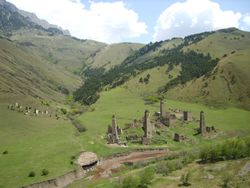إنگوش (شعب)
| |||||||||||||||||
| إجمالي التعداد | |||||||||||||||||
|---|---|---|---|---|---|---|---|---|---|---|---|---|---|---|---|---|---|
| 700,000 [1] | |||||||||||||||||
| المناطق ذات التجمعات المعتبرة | |||||||||||||||||
| 444,833[2] | |||||||||||||||||
| | 385,537 | ||||||||||||||||
| | 1,296 | ||||||||||||||||
| | 28,336 | ||||||||||||||||
| 16,893 | |||||||||||||||||
| 455 | |||||||||||||||||
| اللغات | |||||||||||||||||
| Ingush | |||||||||||||||||
| الدين | |||||||||||||||||
| Predominantly Sunni Islam (Shafii Madhhab) | |||||||||||||||||
| الجماعات العرقية ذات الصلة | |||||||||||||||||
| Chechens, Bats, Kists | |||||||||||||||||
الإنگوش (Ingush ؛ /ˈɪŋɡʊʃ/, Ingush: ГIалгIай؛ Ġalġay، وتُنطق [ˈʁəlʁɑj]) هم جماعة عرقية أصلية قوقازية في شمال القوقاز، mostly inhabiting their native Ingushetia, a federal republic of Russian Federation. The Ingush are predominantly Sunni Muslims and speak the Ingush language, a Northeast Caucasian language that is closely related to Chechen; the two form a dialect continuum.[3] The Ingush and Chechen peoples are collectively known as the Nakh peoples, although the genetics of Ingush and the Chechen indicate a split about 13,000-17,000 Ybp.[4][5]
التاريخ
Caucas is the legendary ancestor of the Vainakh (Chechen-Ingush). The Georgian name is Ghlivi / Ghlighvi.. Ancient author (Strabo) spoke about the Gargars, American cartographer Joseph Hutchins Colton labeled the people as Gelians.
The Ingush came under Russian rule in 1810, but during World War II they were falsely accused of collaborating with the Nazis and the entire population was deported to Kazakhstan and Kyrgyzstan. They were rehabilitated in the 1950s, after the death of Joseph Stalin, and allowed to return home in 1957, though by that time western Ingush lands had been ceded to North Ossetia.
الثقافة
The Ingush possess a varied culture of traditions, legends, epics, tales, songs, proverbs, and sayings. Music, songs and dance are particularly highly regarded. Popular musical instruments include the dachick-panderr (a kind of balalaika), kekhat ponder (accordion, generally played by girls), mirz ponder (a three-stringed violin), zurna (a type of oboe), tambourine, and drums.
العمارة
الأبراج الإنگوشية بنيت بين القرنين العاشر والسابع عشر الميلادي. They are located mainly in the Djeyra district of Ingushetia , and in a small number are also in the Sunzhensky district of Ingushetia.
There are three main types of towers: residential, semi-heavy (in some sources - semi-residential) and fighting. Also to the objects of the ancient Ingush stone architecture are the cult buildings and cemeteries ( necropolises ), located in the perimeter of the tower complexes.
Among the tower buildings, the stones attract attention, on which petroglyphs are carved . They are located on the walls of the building without visible system and symmetry. Among the petroglyphs are signs resembling letters, drawings in the form of crosses, spirals, swastikas , solar circles, images of household items and weapons, tamgas. Sometimes there are figures of people and animals. In this case, people underlined the signs of sex, they are accompanied by not quite clear signs (circles, zigzags, spirals), suggesting that these are images of deities, mythological characters or heroes. Perhaps among them is the "mother of people" - the goddess of fertility Tusholi , especially revered by the Ingush, and also the god Dela[ source not specified 91 day ] . Usually at the entrance to the tower there is an impression of the palm - the hand of the master who erected the building. Leaving it, the builder hoped that the print would become a kind of amulet and guarantee the strength of the creation of the architect.
Significant tower complexes are found in the villages of Erzi , Lalach , Targim , Pui [ce] , Päiling , Hyannis , Egikal , Upper and Lower Lamy , Hamhi , Lyazhgi , Jeyrah .
- الأبراج الإنگوشية
الدين
The Ingush are predominantly Sunni Muslims of the Shāfi‘ī Madh'hab, although a Sufi minority exists.[6]
قاموس بوركهاوز وإفرون الموسوعي، المنشور في نهاية القرن 19 وبدياية القرن العشرين، يبين وجودبعض المسيحيين والوثنيين بين الإنگوش:
جينات الإنگوش
"The Caucasus populations exhibit, on average, less variability than other populations for the eight Alu insertion poly-morphisms analysed here. The average heterozygosity is less than that for any other region of the world, with the exception of Sahul. Within the Caucasus, Ingushians have much lower levels of variability than any of the other populations. The Ingushians also showed unusual patterns of mtDNA variation when compared with other Caucasus populations (Nasidze and Stoneking, submitted), which indicates that some feature of the Ingushian population history, or of this particular sample of Ingushians, must be responsible for their different patterns of genetic variation at both mtDNA and the Alu insertion loci."[7][8]
According to one test by Nasidze in 2003 (analyzed further in 2004), the Y-chromosome structure of the Ingush greatly resembled that of neighboring Caucasian populations (especially Chechens, their linguistic and cultural brethren).[9][10]
There has been only one notable study on the Ingush Y chromosome. These following statistics should not be regarded as final, as Nasidze's test had a notably low sample data for the Ingush. However, they do give an idea of the main haplogroups of the Ingush.
- J2 – 89% of Ingush have the highest reported frequency of J2 which is associated with the Fertile Crescent.[11]
- F* – (11% of Ingush)[10] This haplogroup was called "F*" by Nasidze. It may have actually been any haplogroup under F that was not under G, I, J2, or K; however, it is probably consists of haplotypes that are either under J1 (typical of the region, with very high frequencies in parts of Dagestan, as well as Arabia, albeit in a different subclade) or F3.
- G – (27% of Ingush)[10] Typical of the Middle East, the Mediterranean and the Caucasus. The highest values were found among Georgians, Circassians and Ossetes. There was a noticeable difference in G between Ingush and Chechens (in J2 and F*, Ingush and Chechens have similar levels), possibly attributable to low samples that were all from the same town.
In the mtDNA, the Ingush formed a more clearly distinct population, with distance from other populations. The closest in an analysis by Nasidze were Chechens, Kabardins and Adyghe (Circassians), but these were all much closer to other populations than they were to the Ingush.[10]
انظر أيضاً
الهامش
- ^ http://magas.su/tera/chislo-rodivshikhsya-ingushetii-pochti-408-prevysilo-chislo-umershikh.
{{cite web}}: Missing or empty|title=(help) - ^ "Russian Census 2010: Population by ethnicity". Archived from the original on 2012-04-24. Retrieved 2013-04-16.
{{cite web}}: Unknown parameter|deadurl=ignored (|url-status=suggested) (help) - ^ Nichols, J. and Vagapov, A. D. (2004). Chechen-English and English-Chechen Dictionary, p. 4. RoutledgeCurzon. ISBN 0-415-31594-8.
- ^ Arutiunov, Sergei. (1996). "Ethnicity and Conflict in the Caucasus". Slavic Research Center
- ^ Oleg Balanovsky, Khadizhat Dibirova, Anna Dybo, Oleg Mudrak, Svetlana Frolova, Elvira Pocheshkhova, Marc Haber, Daniel Platt, Theodore Schurr, Wolfgang Haak, Marina Kuznetsova, Magomed Radzhabov, Olga Balaganskaya, Alexey Romanov, Tatiana Zakharova, David F. Soria Hernanz, Pierre Zalloua, Sergey Koshel, Merritt Ruhlen, Colin Renfrew, R. Spencer Wells, Chris Tyler-Smith, Elena Balanovska, and The Genographic Consortium Parallel Evolution of Genes and Languages in the Caucasus Region Mol. Biol. Evol. 2011 : msr126v1-msr126.
- ^ Stefano Allievi; Jørgen S. Nielsen (2003). Muslim networks and transnational communities in and across Europe. Vol. 1.
- ^ Ivane Nasidze; et al. (2001). "Alu insertion polymorphisms and the genetic structure of human populations from the Caucasus". European Journal of Human Genetics. 9 (4): 267–272. doi:10.1038/sj.ejhg.5200615. PMID 11313770.
- ^ Nasidze, I; Risch, GM; Robichaux, M; Sherry, ST; Batzer, MA; Stoneking, M (April 2001). "Alu insertion polymorphisms and the genetic structure of human populations from the Caucasus" (PDF). Eur. J. Hum. Genet. 9: 267–72. doi:10.1038/sj.ejhg.5200615. PMID 11313770.
- ^ Nasidze I, Sarkisian T, Kerimov A, Stoneking M (March 2003). "Testing hypotheses of language replacement in the Caucasus: evidence from the Y-chromosome" (PDF). Human Genetics. 112 (3): 255–61. doi:10.1007/s00439-002-0874-4. PMID 12596050.
- ^ أ ب ت ث Nasidze, I.; Ling, E. Y. S.; Quinque, D.; et al. (2004). "Mitochondrial DNA and Y-Chromosome Variation in the Caucasus" (PDF). Annals of Human Genetics. 68: 205–221. doi:10.1046/j.1529-8817.2004.00092.x. Archived from the original (PDF) on 2011-06-08.
{{cite journal}}: Explicit use of et al. in:|last4=(help); Unknown parameter|deadurl=ignored (|url-status=suggested) (help) - ^ Oleg Balanovsky, Khadizhat Dibirova, Anna Dybo, Oleg Mudrak, Svetlana Frolova, Elvira Pocheshkhova, Marc Haber, Daniel Platt, Theodore Schurr, Wolfgang Haak, Marina Kuznetsova, Magomed Radzhabov, Olga Balaganskaya, Alexey Romanov, Tatiana Zakharova, David F. Soria Hernanz, Pierre Zalloua, Sergey Koshel, Merritt Ruhlen, Colin Renfrew, R. Spencer Wells, Chris Tyler-Smith, Elena Balanovska, and The Genographic Consortium Parallel Evolution of Genes and Languages in the Caucasus Region Mol. Biol. Evol. 2011 : msr126v1-msr126.
وصلات خارجية
- CS1 errors: missing title
- CS1 errors: bare URL
- CS1 errors: unsupported parameter
- "Related ethnic groups" needing confirmation
- Articles using infobox ethnic group with image parameters
- Articles containing Ingush-language text
- Pages using Lang-xx templates
- شعوب القوقاز
- إنگوشتيا
- Nakh peoples
- جماعات عرقية في روسيا Russia
- جماعات عرقية في قزخستان
- جماعات عرقية في تركيا
- جماعات عرقية في العراق
- Muslim communities of Russia














